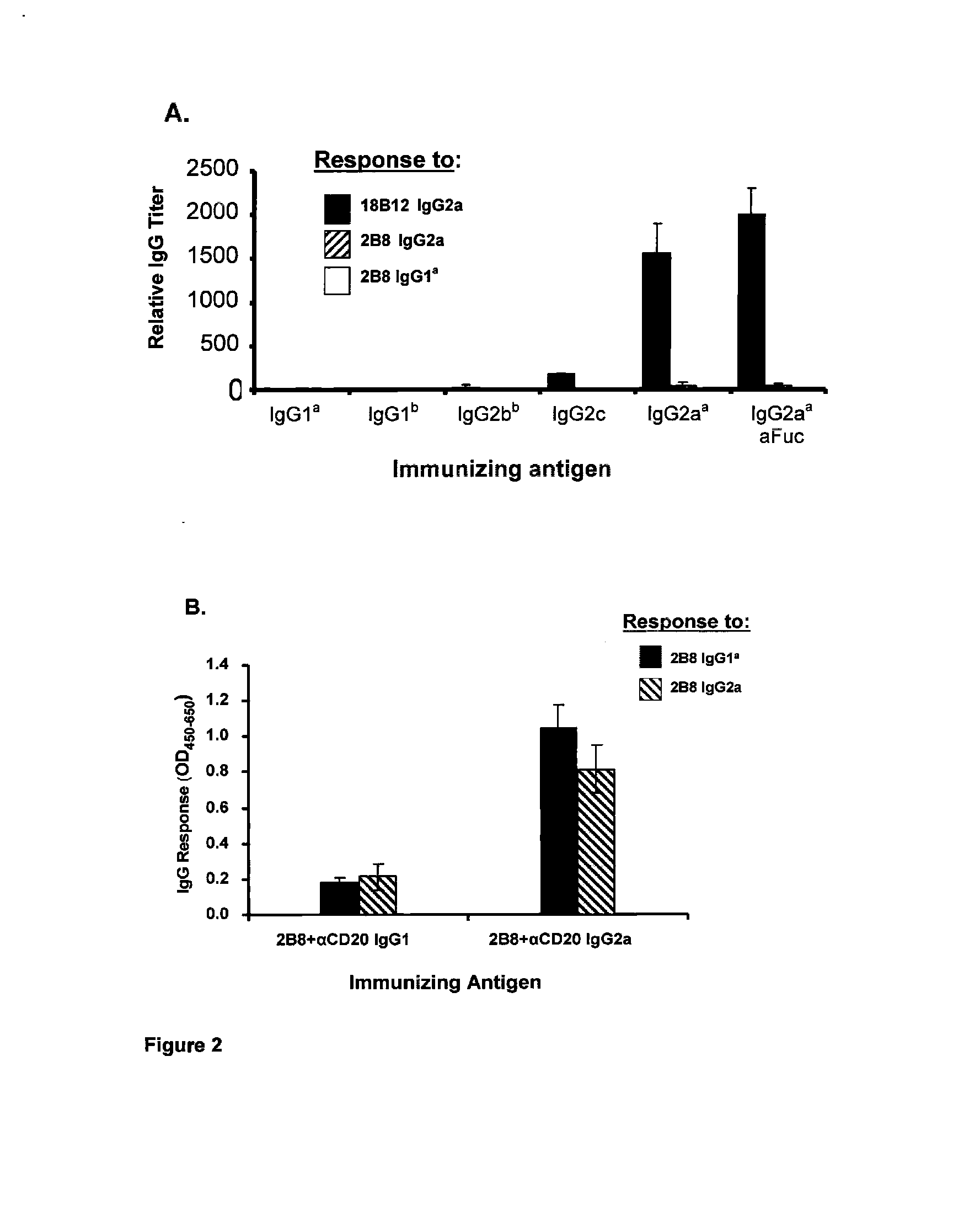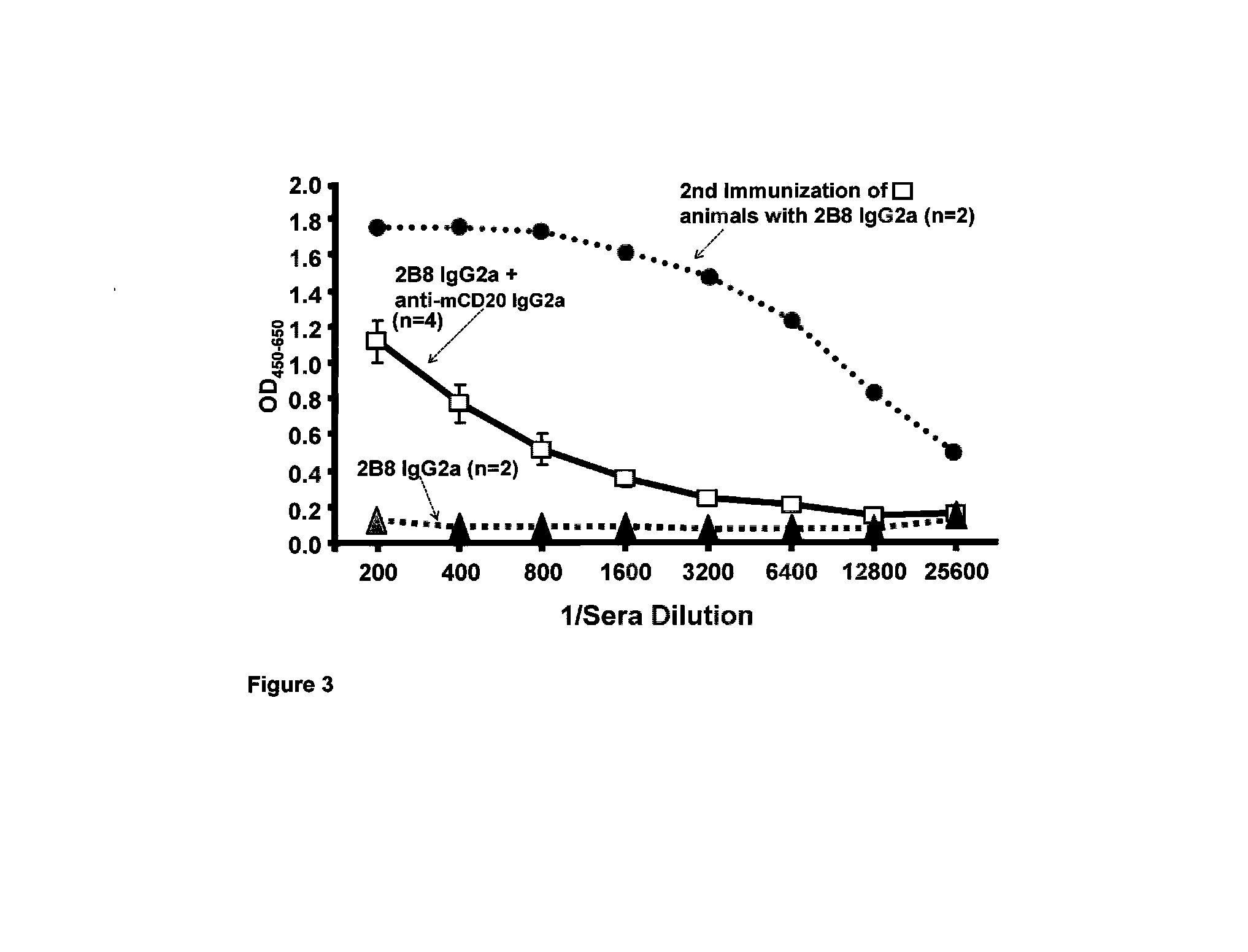Rapid Generation of Anti-Idiotypic Antibodies
a technology of anti-idiotypic antibodies and anti-idiotypic antibodies, which is applied in the field of rapid generation of anti-idiotypic antibodies, can solve the problems of difficult and time-consuming anti-idiotypic antibody generation, prolonged immunizations, and difficulty in generating anti-idiotypic antibody serum titers in mice for monoclonal antibody generation, so as to reduce immune surveillance, shorten the half-life of a therapeutic drug, and reduce or eliminate side effects
- Summary
- Abstract
- Description
- Claims
- Application Information
AI Technical Summary
Benefits of technology
Problems solved by technology
Method used
Image
Examples
example 1
Experimental Procedures
[0075]Generation of Mouse Anti-Mouse CD20 18B12.
[0076]Generation of the mouse anti-mCD20 hybridoma 18B12 and its isotype variants was as described in Patent Application US 2007 / 0136826 A1, incorporated herein by reference.
[0077]Mice.
[0078]NOD (male and female), female SJL, male SWR, male NOR, male C.B-17, male C57BL / 6, and BALB / c mice (male and female) were purchased from the Jackson Laboratories (Bar Harbor, Me.) and housed in the animal facility at Biogen Idec. NOD, NOR, SJL, and C.B-17 mice express the Igh-1b allele of IgG2a (IgG2c); BALB / c mice express the Igh-1a allele (IgG2a); and SWR mice express the Igh-Ic gene. NOR mice are a recombinant congenic strain in which limited regions (˜15%) of the NOD genome have been replaced by genome from the C57BL / KsJ strain in order to map diabetes-related genes (Serreze et al., 1994). Mice were between 8-12 weeks old at the start of all studies. NOD mice were used for all anti-idiotypic antibody generation studies exc...
example 2
Anti-mCD20 IgG2a Isotype Generates an Amplifiable Anti-Idiotypic Antibody Response in NOD Mice
[0087]To test whether the anti-idiotypic antibody response in NOD mice to anti-mCD20 18B12 IgG2a required the IgG2a Fc NOD mice were dosed with either anti-mCD20 18B12 IgG1a, IgG1b, IgG2b, IgG2c, IgG2a, or anti-mCD20 18B12 afucosyl IgG2a and the sera examined for antibody titers to the 18B 12 variable domains. Antibodies were administered in PBS without the adjuvant frequently used during anti-idiotype immunizations. Assessment of sera titers on day 10 post-dosing identified a strong titer of anti-idiotypic IgG antibodies generated to anti-mCD20 18B12 variable domains in mice dosed with 18B12 IgG2a or 18B12 afucosyl IgG2a, but not in those mice dosed with anti-mCD20 18B12 IgG1a, IgG1b, or IgG2b (FIG. 2A). A weak anti-idiotypic IgG response to anti-mCD20 18B12 variable domains was found in mice dosed with anti-mCD20 18B12 IgG2c.
[0088]Additionally, we investigated whether the anti-idiotypic a...
example 3
Enhanced Immunogenicity of Antigens Co-Administered with Anti-mCD20 IgG2a in NOD Mice is Restricted to Variable Domains of Mouse IgG2a Antibodies
[0090]To test whether the enhanced idiotype immunogenicity found in NOD mice after anti-mCD20 IgG2a treatment could be expanded to antigens that were not intact antibodies, mice were immunized with trinitrophenyl (TNP)-KLH (keyhole limpet hemocyanin) and TNP-Ficoll (T-dependent and T-independent antigens, respectively) with or without anti-mCD20 IgG2a co-administration. Additionally, a fusion protein comprised of the extracellular domain of human BDCA2 linked to the mIgG2a Fc and a rat anti-mouse CD103 antibody engineered as a chimeric mouse IgG2a antibody were selected for co-immunization with anti-mCD20 IgG2a. TNP conjugates and human BDCA2, as expected, were immunogenic in the absence of anti-mCD20 IgG2a treatment (FIG. 4). Co-administration of anti-mCD20 IgG2a did not significantly increase their immunogenicity (FIG. 4) although there w...
PUM
| Property | Measurement | Unit |
|---|---|---|
| B cell surface | aaaaa | aaaaa |
| cell surface | aaaaa | aaaaa |
| mean response±SEM | aaaaa | aaaaa |
Abstract
Description
Claims
Application Information
 Login to View More
Login to View More - R&D
- Intellectual Property
- Life Sciences
- Materials
- Tech Scout
- Unparalleled Data Quality
- Higher Quality Content
- 60% Fewer Hallucinations
Browse by: Latest US Patents, China's latest patents, Technical Efficacy Thesaurus, Application Domain, Technology Topic, Popular Technical Reports.
© 2025 PatSnap. All rights reserved.Legal|Privacy policy|Modern Slavery Act Transparency Statement|Sitemap|About US| Contact US: help@patsnap.com



